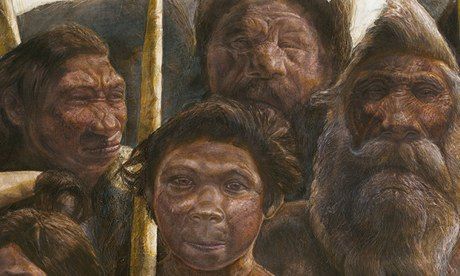The genetic material was pieced together from a clutch of cells found in bone fragments - the oldest human remains ever to yield their genetic code.
The work deepens understanding of the genetics of human evolution by some 200,000 years, raising hopes that researchers can build a clearer picture of the earliest branches of the human family tree by studying the genetic make-up of fossilised remains dug up elsewhere.
"This is proof of principle that it can be done," said Matthias Meyer at the Max Planck Institute for Evolutionary Anthropology in Leipzig. "We are now very eager to explore other sites of a similar age."
The thigh bone was among the remains of at least 28 early human ancestors found at the bottom of a vertical shaft in a cave complex in the Atapuerca mountains in northern Spain. The Sima de los Huesos, or "pit of bones", lies 30m underground and half a kilometre from the cave system's nearest current entrance.
The individuals at Sima de los Huesos looked a little like Neanderthals, and many anthropologists classified them as Homo heidelbergensis, a potential forerunner of modern humans. The corpses at Sima de los Huesos were likely washed into the pit rather than buried intentionally.

The age of the bone fragments meant the cells and their DNA was badly degraded. "This is the hardest sample I have ever worked on that yielded a result," said Meyer.
Meyer's team dated the bone fragments to 400,000 years old, but further analysis left them baffled. The mitochondrial DNA did not match that of Neanderthals, but was closer to a sister group called the Denisovans that lived in Siberia. Details of the study appear in the journal Nature.
Meyer says there are a number of explanations, but admits more work is needed. One possibility is that an older lineage of human ancestors, perhaps Homo erectus, bred with the ancestors of the Sima de la Huesos individuals, and passed on their mitochondria. But several other explanations are being explored by anthropologists.
"Either way, this new finding can help us start to disentangle the relationships of the various human groups known from the last 600,000 years," said Chris Stringer, head of human origins at the Natural History Museum in London. "If more mitochondrial DNA can be recovered from the Sima population of fossils, it may demonstrate how these individuals were related to each other, and how varied their population was."
Meyer said the Leipzig group now hopes to extract so-called nuclear DNA from the Sima fossils, which contains more information but will be much harder to extract because there is far less material.
"We have taken a first glimpse now and what we find is unexpected and confusing," he said. "But I'm confident we'll get more data, and then it's very likely we'll be able to nail down some hard facts, about whether these Sima de la Heusos guys are the ancestors of Neanderthals, the ancestors of both Neanderthals and Denisovans, or even something completely different."
[Digital illustration of DNA with blood cell via Shutterstock]
Source: The Guardian




Reader Comments
to our Newsletter